 Not too long after wargames started appearing in stores, wargamers got frustrated with small units holding up the advance of overwhelming stacks, simply because those little units had to be attacked - and so was born the overrun. In Europa the overrun has been with us (except for Narvik) ever since Drang Nach Osten. The overrun is a powerful tool and an important concept for all players, whether on the strategic offensive or defensive. By knowing how to conduct an overrun a player will know how to protect against them as well.
Not too long after wargames started appearing in stores, wargamers got frustrated with small units holding up the advance of overwhelming stacks, simply because those little units had to be attacked - and so was born the overrun. In Europa the overrun has been with us (except for Narvik) ever since Drang Nach Osten. The overrun is a powerful tool and an important concept for all players, whether on the strategic offensive or defensive. By knowing how to conduct an overrun a player will know how to protect against them as well.
Overruns are so important that they have their own rules section, Rule 13 -Overruns, and most of the rules concerning them can be found there; but of course, other rules sections come into play as well. Let's look at this rule in detail. First, for reference, here is the exact text of the overrun rule as taken from Second Front appears to the right.
To summarize, overruns are performed in movement and exploitation phases by phasing units which can both achieve 10:1 or greater odds versus the defending unit/s and which can pay all MP costs associated with normal movement and the special overrun movement costs. The overrun must be performed by moving the overrunning unit/s from one hex adjacent to the defender, into the defenders hex (they need not have been stacked together before the instant of overrun.) The odds calculation is made as if an attack, that is, combat, were being performed and includes most (but not all) considerations that affect combat strengths and combat odds.
Note the following and how they affect overruns.
Rule 13: Overruns
Phasing units may overrun enemy units in the movement and exploitation phases. The phasing player performs an overrun by moving units into a single hex adjacent to the enemy units to be overrun; the overrunning units may not exceed the stacking limit of the hex being overrun. All overrunning units must be able to enter the hex being overrun. The overrunning units must have a total attack strength sufficient to achieve at least 10:1 odds against the enemy units. Overrun odds are computed in the same way that combat odds are, taking all terrain, supply, stacking, and support modifications into account.
Units being overrun lose their ZOCs at the instant of overrun. Each overrunning unit must then spend MPs sufficient to enter the hex being overrun, paying all terrain, ZOC, and overrun MP costs. (Note that ZOC costs are not paid due to units in the hex being overrun, but are paid due to enemy units in adjacent hexes.) Each unit participating in an overrun must pay overrun MP costs, as given on the overrun movement costs table. A unit with insufficient MPs to pay the full MP costs for an overrun may not participate in the overrun, even if it has not moved at all in the phase.
Overrunning units may use the road, movement rate when executing an overrun if all other considerations for road movement are met.
The units in the hex being overrun are completely eliminated and removed from play (even if they have cadres), and the overrunning units may advance into the hex. This advance is optional, but each overrunning unit must spend the required MPs to enter the hex even if it does not advance. After executing an overrun, the units may continue moving if they have sufficient MPs remaining.
A unit with a defense strength of 0 may be overrun at 12:1 odds by any unit with an attack strength greater than zero.
A unit that may retreat before combat (Rule 91) may use this ability when enemy units overrun the hex it occupies. When the overrun is announced, these units may immediately retreat, using the retreat before combat rule, at the owning player's option. The overrun odds are then recalculated (if necessary), and the overrun resolved. If all units in a hex being overrun retreat before combat, then the overrunning units do not pay the overrun MP cost for the overrun attempt.
Terrain
The hex the defender is in, and the hexside that the overrun units cross, both affect combat calculations normally. So, for example, non-artillery units overrunning a hex across a non-frozen river hexside would be halved, and all non-mountain units overrunning a unit in a mountain hex would be halved. While units may use the road movement rules, to reduce MP costs of terrain, remember that roads do not affect combat and so are ignored for overrun odds calculations purposes. For example, during Winter weather, mountain hexes and mountain hexsides are prohibited terrain for Mot/Art units, so they could not participate in an overrun involving those terrain types, regardless of the presence of roads. Note also that causeways (Rule 37A.1) are a distinct terrain concept from roads and units may overrun across them, treating the hexside as a major river hexside.
Supply
The supply status of all units involved in the overrun affect things normally, such that a defending unit at U-2 or worse would defend at half strength and the overrunning units would be halved if at U-1 and isolated, or if at U-2 or worse. Note that for games that use attack supply, the overrun strength of a unit in general supply is its full attack strength, even though its attack strength for normal combat is halved; units do not require attack supply to overrun at full strength. .
Stacking
The stacking capacity of the defenders hex is used to judge stacking for die overrunning units; overrunning units ignore the defending units for stacking purposes. Since the overrun occurs during movement, stacking limits do not apply to the overrunning units in the hex they are overrunning from. Therefore, overrunning units must abide by stacking limits as to how many units and which types may be counted for the overrun, depending on the terrain and other factors in the defenders hex. Such other factors include weather zone (that is, Arctic stacking on or north of the A weather line) and/or terrain (only mountain stacking allowed into a mountain hex). Note that this would also apply to the Soviets in AWW, who operate under reduced stacking rules.
For example, let's imagine an overrun from a mountain hex into a clear hex, south of the A weather line (for all purposes, assume in all examples that they are occurring south of the A weather line, unless stated to be occurring north of the A weather line.) The number of units which can participate in the overrun vs. the enemy unit would be normal stacking limits, i.e. 3 units of any size and type, 3 REs of non-divisional units and one artillery division OR 2 REs of artillery units. The stacking limit of the hex the overrunning units are overrunning from is ignored, since stacking limits do not apply during movement. But the stacking limit of the hex being overrun is not ignored, since the overrun is treated as a combat and stacking limits do apply to units participating in combat.
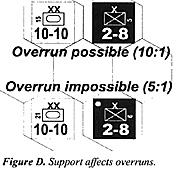 Support
Support
See Figure D. For both the overrunning units and the defending units, support status is handled normally. For example, note that this 10- 10 Pz XX may overrun the 2-8 Inf X ' since the X is halved for lack of support to only one defense strength point thus a 10: 1 overrun. But if the defending unit was instead a self-supported 2-8* Inf X, then the 10-10 Pz XX could not overrun the unit, this being only 5:1 combat odds.
Air Support
Since ground support and defensive air support missions are flown only during the combat phase (and return to base at the conclusion of the combat phase) no air units may participate in or affect overruns, whether during movement or exploitation phases.
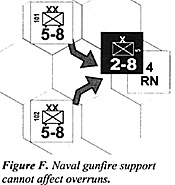 Naval units
Naval units
Since naval gunfire support is only fired during combat phases, it may only affect combats and not overruns. This applies equally to the firepower of the naval units and any support ability that gunfire might provide during a combat phase, neither is included in overrun calculations. For example, note the NZ 2-8 Inf X stacked with the Br 4 pt naval task force. Since the naval unit may not provide NGS during movement or exploitation phases it may not be counted as art strength for the overrun, nor may it provide support, per Rule 11, to the unsupported Inf X. The two It 5-8 motorized infantry XXs may overrun the unit at 10:1.
Other Terrain Considerations
Special rules that affect either movement and/or combat do apply to overruns. For example, an assault engineer overrunning a unit in a major city or improved fortress would have its attack strength doubled, but would have only normal strength when overrunning a unit in a fort counter. (Rule 14A.3) Amphibious tank units and units riding LVT counters, could overrun across lake hexsides, treating the hexside as a river instead (Rule 14J.2 and 14K), and such units would treat a major river as a river for movement and overrun purposes. Siege artillery units would have doubled attack strength when overrunning units in a major city or those fortifications that include the "Siege Art. doubled" note.
While the above notes and examples are not exhaustive, they should serve to demonstrate that one handles the overrun as a combat, that is, apply any rules and limitations that would apply were the overrun being conducted as a combat during a combat phase, remembering always that the overrun is conducted during movement/exploitation phases and must also abide by limitations that affect those phases.
Continuation of Rule 13
Rule 13 continues...
each overrunning unit must then spend MPs sufficient to enter the hex being overrun, paying all terrain, ZOC and overrun MP costs." Due to their special training and abilities, German (not Axis) combat motorized (not any, but only German c/m) units pay reduced costs when overrunning. These costs are detailed on the Overrun Movement Costs chart, which is included on a chart with each game.
| Unit Type | Odds | |
|---|---|---|
| 10 to 1 | 12 to 1 | |
| German combat motorized units | 2 MPs | 1 MP |
| All other units | 3 MPs | 2 MPs |
These costs also depend upon the combat odds which apply to the overrun; either at least 10: 1 or 12: 1 and greater. German c/m units pay 2 MPs for a 10: 1 overrun, and I MP for 12:1 overruns. All other units (inc. German non-c/m units) pay 3 MPs for 10: 1 overruns and 2 MPs for 12:1 overruns. The rule also tells us that "... the overrunning units may (my emphasis) advance into the hex. The advance is optional, but each overrunning unit must spend the required MPs to enter the hex even if it does not advance." In other words, although the units conducting the overrun must spend the MPs that entering the overrun hex would require, they do not have to enter the hex physically.
Examples
Now let's look at some examples. For each, assume clear weather, all units in general supply and the action takes place south of the A weather line.)
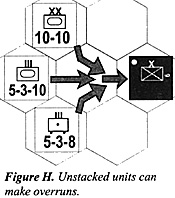 In Figure H, the German 5-3-8 mot Art III, 5-3-10 Pz III and 10-10 Pz XX are going to overrun the South African 2-8* Inf X. Notice that none of the German units occupy the same hexes, but move individually to the hex from which they will launch the overrun. (the "common hex").
In Figure H, the German 5-3-8 mot Art III, 5-3-10 Pz III and 10-10 Pz XX are going to overrun the South African 2-8* Inf X. Notice that none of the German units occupy the same hexes, but move individually to the hex from which they will launch the overrun. (the "common hex").
The 5-3-8 mot Art III expends one MP to enter the common hex, the 5-3-10 Pz III expends 2 MPs to enter the common hex and the 10-10 Pz XX expends 3 MPs to reach the common hex. Each unit expends one MP for the overrun hex and, since this is a 10: 1 overrun and all units are German c/m units, each pays 2 additional MPs for the overrun. The 5-3-8 mot Art has expended 4 MPs, the 5-3-10 Pz II15 MPs and the 10-10 Pz XX 6 MPs. No ZOCs affect the overrun. The overrun is resolved, the South African 2-8* Inf X is eliminated and the units participating in the overrun may continue movement (or exploitation, as the case may be.) Also note that the overrunning units may, but are not required to, advance into the overrun hex before continuing their movement. They have already paid for this advance when the overrun was performed.
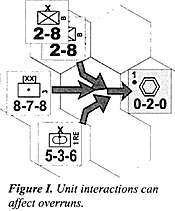 In Figure I, the Br 8-7-8 Art [XX], the 5-3-6 Assault Eng Tank X and the two 3-8 Inf X's are going to overrun the German 02-0* port fortification.
In Figure I, the Br 8-7-8 Art [XX], the 5-3-6 Assault Eng Tank X and the two 3-8 Inf X's are going to overrun the German 02-0* port fortification.
All units will expend one MP to enter the common hex, one MP for the defender's hex and 3 MPs for the overrun (10: 1, nonGerman c/m units). Note that the Art [XX] provides support to the three unsupported Br X's, the three non-artillery REs allow the 8-7-8 to attack at full strength (Rules 11 and 14B.) The Artillery [XX] is not halved for the port fort. The two Inf X's are halved for the port fort and the Assault Engineer Tank unit will have its attack strength doubled, since the port fort is treated as an improved fortress. (Rule 37B.2) [Note that if using Optional Rule 44G.3, the major port's coastal defense strength would provide I strength point of defense, making the defender equal 3 DF, thus no overrun could occur, 20:3 is not 10: 1 or greater.]
Figure J shows three German 10-10 Pz XXs that will overrun the Soviet 3-6 Inf XX.
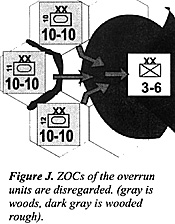 Note again how the 3 overrunning units begin in different hexes but all move to the common hex, before performing the overrun. Each spends two MPs to enter the common hex (woods), except for 11 th Pz XX which also must cross a river, it pays 3 MPs to enter the common hex. It will cost 3 MPs to enter
the wooded-rough hex the defender is in, and another 2 MPs for the 10:1 overrun. Pz XXs 10 and 12 will spend a total of 8 MPs
while 11th Pz XX has spent 9 MPs; the units may now continue movement, either from the common hex, or the overrun defenders
hex (the optional advance again .... )
Note again how the 3 overrunning units begin in different hexes but all move to the common hex, before performing the overrun. Each spends two MPs to enter the common hex (woods), except for 11 th Pz XX which also must cross a river, it pays 3 MPs to enter the common hex. It will cost 3 MPs to enter
the wooded-rough hex the defender is in, and another 2 MPs for the 10:1 overrun. Pz XXs 10 and 12 will spend a total of 8 MPs
while 11th Pz XX has spent 9 MPs; the units may now continue movement, either from the common hex, or the overrun defenders
hex (the optional advance again .... )
Note that even though the defender (per WitD rules) has a ZOC in all adjacent hexes and in its own hex, the Pz XXs pay no ZOC costs for moving from ZOC to ZOC, since the ZOC of the unit being overrun is not present once the overrun begins. "Units being overrun lose their ZOC at the instant of the overrun." The instant of the overrun is when the overrunning units have entered the common hex and have enough strength to perform the overrun; at that point the MP costs for the overrun are calculated, with the unit being overrun now having no ZOC. Still with this basic situation, let's add in some ZOCs to muddy the waters.
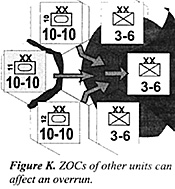 With two other Soviet divisions present, shown in Figure K, we can see that the overrun is no longer possible. Pz XXs 10
and 12 expend 4 MPs to enter the woods hex, (2 MPs for the terrain, 2 MPs for moving ZOC to ZOC) and then would have to
pay 7 MPs to perform the overrun. (3 MPs for terrain, 2 MPs for the overrun and 2 MPs for moving ZOC to ZOC) This equals out to 11 MPs, more than the divisions have. 11th Pz XX would still pay 3 MPs to enter the common hex (woods and river hexside) and it is entering a ZOC, but not moving from ZOC to ZOC. From the common hex, it would spend the same 7 MPs as the other units; so while it has sufficient MPs to participate, no other units could, and 10:3 is not 10:1 or greater. Therefore, no overrun can occur. So what happens when there is no defense strength in the hex, but it is enemy occupied? The rules say, "A unit with a defense strength of 0 may be overrun at 12:1 odds by any unit with an attack strength greater than zero." One can extend this logically to apply to hexes with two or more zero strength units as well.
With two other Soviet divisions present, shown in Figure K, we can see that the overrun is no longer possible. Pz XXs 10
and 12 expend 4 MPs to enter the woods hex, (2 MPs for the terrain, 2 MPs for moving ZOC to ZOC) and then would have to
pay 7 MPs to perform the overrun. (3 MPs for terrain, 2 MPs for the overrun and 2 MPs for moving ZOC to ZOC) This equals out to 11 MPs, more than the divisions have. 11th Pz XX would still pay 3 MPs to enter the common hex (woods and river hexside) and it is entering a ZOC, but not moving from ZOC to ZOC. From the common hex, it would spend the same 7 MPs as the other units; so while it has sufficient MPs to participate, no other units could, and 10:3 is not 10:1 or greater. Therefore, no overrun can occur. So what happens when there is no defense strength in the hex, but it is enemy occupied? The rules say, "A unit with a defense strength of 0 may be overrun at 12:1 odds by any unit with an attack strength greater than zero." One can extend this logically to apply to hexes with two or more zero strength units as well.
Let's imagine some extremely poor play for a change! An Allied attack from a hex has resulted in an AR, however, the hex was overstacked. The units which attacked must retreat, but the overstacked units, which could not attack, are not affected by the combat result and are left in the hex. Note that they are still overstacked (they can only leave overstack through movement) and that they will defend with a combined total of zero defense strength (Rule 43C.2). Thus, if the conditions still exist in the following Axis player turn, any Axis unit with an attack factor greater than zero could overrun the entire stack at 12:1 odds!
The rules also allow for those few units able to retreat before combat; they are, in effect, also allowed to retreat before overrun. Such units simply retreat when the overrun is announced, using normal retreat before overrun rules. The overrun is then recalculated, if there are any enemy units left in the hex. If all of the units in a hex retreat before overrun, then no MPs are paid for the overrun attempt since it doesn't take place. Obviously then, it costs no extra MPs to enter an otherwise unoccupied hex after any units there have retreated before overrun. Note also that no restrictions on retreat before combat (or overrun) exist as far as the number of times it may be usedan eligible unit may retreat before overrun as many times as it is able, within the bounds of the rule. (Rule 91)
One part of the overrun rule that seems to cause problems is the (erroneous) idea that units must be stacked together at the start of a phase to participate in overruns. This is false. Units involved in an overrun need only be stacked together in the common hex, at the instant of overrun. Some players seem to be also under the impression that Europa uses some form of "touch move", like in chess, such that one unit must end all its movement before another unit may begin moving; this is also false. Units may move in any order that the owning player wishes and need not complete their movement before other units move. As was seen in the example above (A), one unit may expend some MPs, then another one some of its MPs, and then the first one continue moving, and on and on.
This ability is only useful for overruns and some engineering type functions so it usually doesn't become a playability problem. When appropriate, a player could use numbered status markers, or scratch paper, to record MPs spent, or remaining, for units moving in this manner. Overruns often involve units from multiple hexes converging upon the common hex, and having spent various amounts of their MPs to get there. It may then cost the units differing amounts of MPs to perform the overrun, and some may and others not, advance into the overrun hex, some may then choose to continue moving, while others may choose not to, or may be incapable of further movement. All of this is quite legal and proper. Just remember that the overrun must be launched from one hex (the common hex), must abide by normal stacking rules with regards to how many units may "attack" the defender's hex and that all units participating must be able to expend all of the MPs required for the overrun.
Amphibious and Airborne Overruns
Second Front introduced the concepts of "amphibious" and "airborne" overrun. These are handled like other overruns, except that the overrunning units will be in the same hex as the units to be overrun. If the invading or air-dropping units are able to achieve an overrun, using all normal rules, like support terrain, etc. (excepting movement costs), then the defending units may be overrun and the invading/air-dropping units will be free to attack other units in the following combat phase. However, since almost all invading/air-dropping units will be unsupported when they perform their special operation, their ability to overrun other units is severely limited.
Also, the only units that can participate in this sort of overrun are those that arrived in the hex through special operations and normal stacking rules apply. For example, imagine an amphibious overrun by an average full stack of Allied invading units, landing in a clear terrain hex during calm seas. We will assume the attackers are breakdown counters from one 9-8 Inf XX, (2x 3-8 Inf X and 1x 2-8 Inf X) 2x 2-3-8 Eng X's, and a 3-8 Mar Commando X. The infantry and engineers are halved for lack of support and quartered for the amphibious landing, 12 attack strength divided by 8 equals 1.5 attack strength plus the Commando, who is only halved, or 1.5 attack strength. Our total for any overrun is therefore only 3 attack strength; even against an unsupported one DF unit this is still only a 6:1, insufficient for an overrun. However, we can imagine more powerful stacks. An amphibious assault mounted by 2x 6-4-10 amph Tank X's and 4x 3-8 Mar Cdo X's ( 12/2 + 12/2) equals an attack strength of 12 points, sufficient to overrun either an unsupported 2 factor unit or a supported one factor unit. Note that the overrun and the landing are limited by normal stacking. that is, three units (in this case brigades) and 3 REs of non-divisional units (again, three brigades). Airborne overruns are handled similarly, and could even include some supported units, if one or more airdroppable divisional HQs were able to airdrop successfully into the hex.
Common Complaints
Throughout the years, many people have attempted refinements to the overrun rules, the most popular change being one in which combat die roll modifiers and an actual combat die roll are incorporated into the rules, with overruns occurring if the overrunning units achieve a DE result on the combat results table. These, and similar changes, are put forward in an attempt to stop the accepted play practice of calculating exact defense strengths needed to prevent overruns; the idea being that the variability of using a CRT, will lessen the reliance upon "calculating" play. While it is not my place to offer an opinion one way or the other on such modifications to the system, I will note two things. First, John Astell has never included such a rule in any published game, not even as an advanced rule, seeming to indicate either a feeling that such is not needed or that it may imbalance the game. Second, on the other hand, John Astell is also one of the people who has offered a version of a CRT based overrun rule in the past. For those interested in experimenting with such rules, his is probably the best version so far. It appears on the following page.
| John Astell's Proposed Variable Overrun Rule from TEM#40 | |||
|---|---|---|---|
| Overrun Odds | Germ c/m | Others | Result |
| 12:1 + | 1 | 2 | Total Elim |
| 10:1,11:1 | 2 | 3 | Total Elim |
| 9:1 | 3 | 4 | Grnd CRT |
| 8:1 | 4 | 5 | Grnd CRT |
| 7:1 | 5 | 7 | Grnd CRT |
| 6:1 | 7 | 9 | Grnd CRT |
| 5:1 | 9 | X | Grnd CRT |
| 4:1 or less | X | X | - |
| c/m = Combat Motorized | |||
Total Elim: enemy units are totally eliminated and removed from play completely, even if they have cadres.
Grnd CRT: Use the ground combat results table to resolve the overrun.
X No overrun is possible at these odds for the indicated units.
Calculate the overrun odds normally, the only change is that now overruns can occur at less than 10: 1 odds.
Overrun Movement Costs
The overrun odds determine the MP cost each unit must spend to participate in the overrun, per the overrun movement cost columns on the summary. As always, if a unit does not have sufficient MPs to pay ALL costs associated with the overrun, it may not participate.
Grnd CRT
Overruns at 10: 1 or more still result in the complete elimination of the units being overrun, per the standard rules. For odds of 9:1 or less, resolve the overrun using the Ground combat results table, applying all die roll modifiers (for terrain, AEC/ATEC, etc.) as normal. Roll the die, find the result, and implement it per the combat rules (including any retreat and advance after combat). Note that armor, through AEC effects, can be especially effective in a low odds overrun, unless you're foolish enough to do something like sending in the tanks against a fortress stuffed with anti-tank weapons.
After Effects
If the overrun result was either Total Elim. or DE, the units participating in the overrun can continue to rock & roll: they can continue to move, overrun, participate in combat in the combat phase, etc. If the result was anything else, the participating units have shot their wad and cannot move (or otherwise spend MPs) for the rest of the phase. In addition, if the overrun occurred in the movement phase, these units cannot attack during the following combat phase.
Back to Europa Number 61 Table of Contents
Back to Europa List of Issues
Back to MagWeb Master Magazine List
© Copyright 1998 by GR/D
This article appears in MagWeb (Magazine Web) on the Internet World Wide Web. Other military history articles and gaming articles are available at http://www.magweb.com